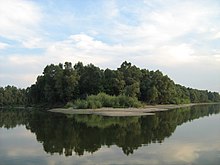Gornje Podunavlje
Gornje Podunavlje (in German Upper Danube Lowland ) is a nature reserve in the Zapadna Bačka district in the northwest of the autonomous province of Vojvodina in Serbia . It is one of the five special nature reserves in Serbia.
It is a very important protected area that has existed since 1982 on an area of 10,000 hectares along the Danube . In it is one of the last reed forests with many bodies of water, swamp areas and meadows, which is very rich in various animal and plant species. This reserve borders on the Danube- Drava National Park in Hungary to the north and the Kopački rit nature park in Croatia to the west .
flora
The white willow , the black poplar , the white poplar and the Euro-American poplar, for example, thrive here , but the most impressive are the forests with the holm oaks , which temporarily leave their places to other plant species due to the artificial dams.
fauna
Many mammals live in this reserve, various species of mice and even some wild species such as deer .
The bird life is particularly pronounced in this natural area . With over 230 species, it is also the most varied in Serbia, as 70 percent of the Serbian bird species can be found here.
The most important animal species in the reserve are:
- The cormorant is a rare species of bird in Serbia that was already considered extinct there. However, some cormorant colonies have reappeared in the past fifteen years. When foraging for food, these birds can very often be seen in the reserve.
- The black stork is very rare in Serbia. About 25 pairs of storks live in the reserve, which is a quarter of the total Serbian black stork population.
- The heron is also present here with some permanent settlements, according to the reserve statistics from 1999.
- The white-tailed eagle is the largest bird of prey in Europe. 30 percent of the white-tailed eagles in Serbia and Montenegro breed their eggs in this nature reserve.
- Both wild ducks and wild geese gather here in winter and during the mating season. More and more couples have been identified over the years.
The reserve is also rich in fish species . The favorable conditions enable the fish to multiply quickly. Around 50 species of freshwater fish can be found in the reserve. The most common species are carp , catfish , pike and pikeperch . Very strong efforts by the reserve are being made to maintain the quantity of fish.
See also
- Special nature reserve Deliblatska peščara
- Special nature reserve Obedska bara
- Special nature reserve Ludaško Jezero
- Special nature reserve Stari Begej - Carska bara
Web links
Coordinates: 45 ° 45 ′ 50 " N , 18 ° 55 ′ 34" E
